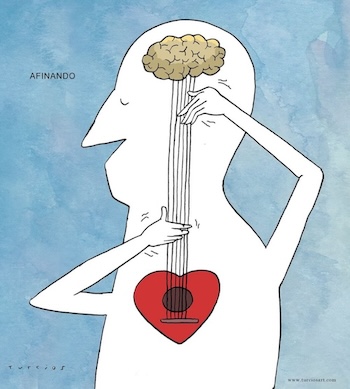
When we are under acute or chronic stress, our amygdala (part of the limbic system of the brain) can hijack the pre-frontal cortex (PFC) – this means that executive function and strategizing gets tossed out in favor of emotions, which are inherently irrational. It’s a helpful evolutionary strategy for dealing with life-or-death situations, but can be problematic when it happens too frequently or too quickly. The result is emotional dysregulation (having a “short fuse”), and can also make it hard to learn and function well in school, for example.
Fortunately, there is an easy-to-learn breathing technique that balances the amygdala-PFC connection. There are many names for it: Coherent Breathing, Resonance Breathing, Slow Paced Breathing.
It comes from the study of HRV biofeedback — a therapy that uses biofeedback of the heartbeat to train how to control breathing, such that there is a large swing in the heart rate with each breath (speeds up on the inhale, slows down on the exhale). This is called Respiratory Sinus Arrhythmia (RSA) has to do with the effect of the vagus nerve acting as a brake on the pacemaker of the heart.
Breathing at a rate of 5.5 or 6 breaths per minute gives the ballpark frequency which maximizes the swings in the heart rate (RSA). The video below is a very popular soundtrack which you can breathe along to as a form of meditation (eyes open or closed). It is also available on Spotify: Two Bells - Coherence
Remember to breathe naturally – don’t hyperventilate by breathing too deeply. Inhale through your nose gently like you are smelling a flower. My might also experiment with exhaling through pursed lips with a little pressure, like you are blowing bubbles through a straw.
For extra credit, feel your pulse on your neck or wrist and notice how it speeds up and slows down as you breathe. This “interoception” (awareness of internal body functions) also helps with emotional regulation. You can amplify this heart rate swing even further by contracting your PC/Kegel muscles on the inhale, and relaxing them on the exhale.
What is so cool is that this practice balances the nervous system — it’s NOT a relaxation practice but rather the fusion of sympathetic and parasympathetic branches working together in harmony. So it actually “lubricates and strengthens” the switching mechanism between both sides of the Autonomic Nervous System.
If you want to geek out about why this works, check out the paper referenced below.1 TL;DR The parts of the brain that use interoception to control changes in heart rate also regulate emotions! 🤯 Basically it is thought that Resonance Breathing connects the body and brain via Neurovisceral Integration2 (regulating top-down and bottom-up connections between organs and the brain).
HRV Biofeedback for 5 weeks daily was proven to change the structure and function of the brain!3 15-20 minutes of Slow-Paced / Coherent Breathing will likely give you similar results (enhanced cortical thickness and amygdala-PFC connectivity).
What is so cool is that this practice balances the nervous system — it’s NOT a relaxation practice but the fusion of sympathetic and parasympathetic branches working together in harmony. So it actually “lubricates and strengthens” the switching mechanism between both sides of the Autonomic Nervous System.
I gave a talk about my Pranawave HRV Biofeedback software in October 2017. I think it’s time to give a new one, based on what I’ve learned since then!
References
-
Mather & Thayer (2018) How heart rate variability affects emotion regulation brain networks. ↩︎
-
Thayer JF, Lane RD (2008). Claude Bernard and the heart-brain connection: further elaboration of a model of neurovisceral integration. PMID: 18771686. ↩︎
-
Yoo et al. (2022) Heart rate variability (HRV) changes and cortical volume changes in a randomized trial of five weeks of daily HRV biofeedback in younger and older adults. ↩︎